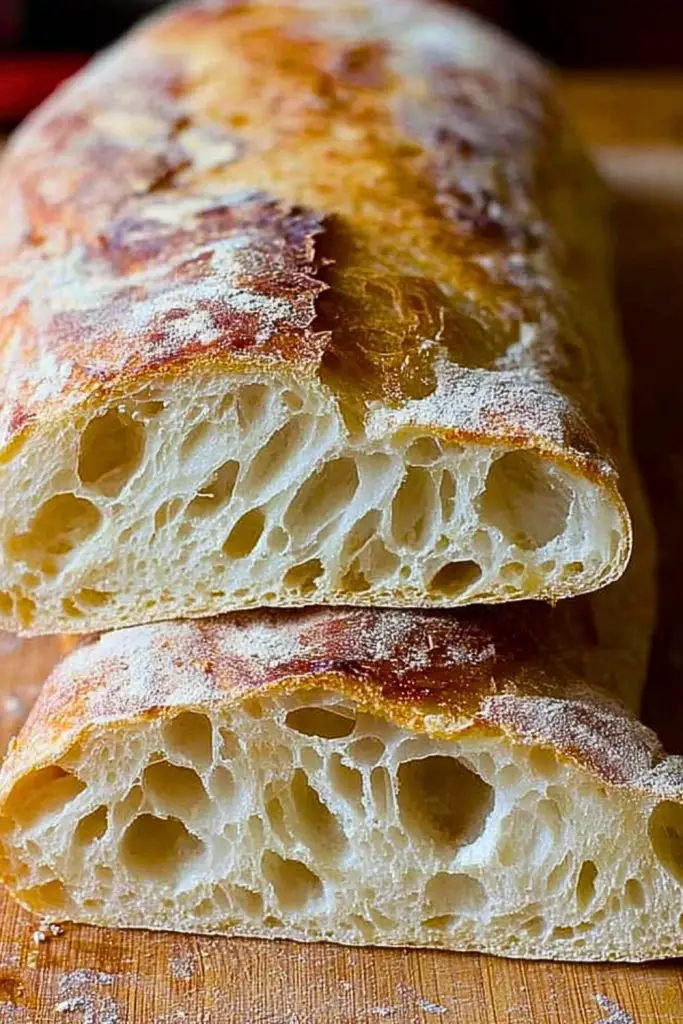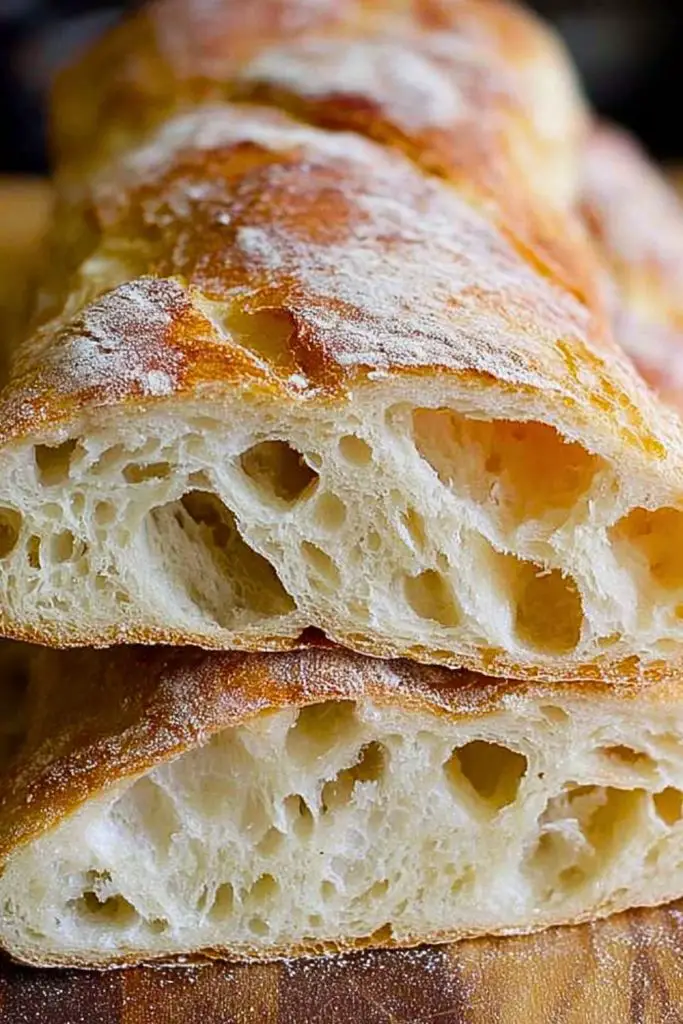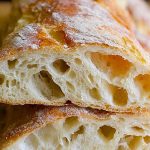Few things in life match the joy of slicing into a freshly baked loaf of homemade ciabatta bread. With its rustic, golden crust and beautifully airy crumb, ciabatta is the kind of bread that turns an ordinary sandwich into a gourmet experience. It’s the ultimate artisan-style loaf—crackly on the outside, soft and chewy on the inside, and packed with flavor that can only come from a slow fermentation process.

Originally from Italy, ciabatta translates to “slipper,” referring to its long, flat shape. This bread is beloved not just for its taste but also for its versatility. Whether you’re dunking it in olive oil, layering it with cured meats, or using it to mop up the last of a pasta sauce, ciabatta adds that perfect rustic touch to any meal.
Why You’ll Love This Ciabatta Bread
Homemade ciabatta is everything store-bought bread wishes it could be. It boasts an incredibly light and open crumb, thanks to its high hydration dough and long proofing time. You’ll love how it fills your kitchen with a warm, yeasty aroma while baking—and even more when you tear into that crisp, crackling crust. Plus, it requires just a few simple ingredients: flour, water, salt, and yeast. No preservatives, no gimmicks—just honest, beautiful bread.
Preparation Phase & Tools to Use
Before you start, get your gear ready. Here’s what you’ll need:
- Mixing Bowls: For combining and proofing the dough.
- Stand Mixer with Dough Hook (optional): Speeds up kneading, but hand-kneading works too.
- Bench Scraper: Essential for handling sticky dough without deflating it.
- Proofing Container or Large Bowl: To give the dough room to rise.
- Baking Stone or Steel (optional): Helps achieve a crispy, evenly baked crust.
- Parchment Paper & Baking Sheet: Useful if you don’t have a stone.
- Spray Bottle with Water: For creating steam in the oven to enhance crust texture.
Each of these tools plays a crucial role in creating the texture and structure that ciabatta is known for. Don’t skip on prep—it’ll make your baking smoother and more enjoyable.
Preparation Tips
Hydration is key when it comes to ciabatta. The dough will be wet and sticky—resist the urge to add too much flour. Instead, rely on gentle folds during bulk fermentation to develop strength. Give the dough time; patience during rising and proofing is what creates that signature airy structure. Use a light dusting of flour or semolina on your work surface and hands to manage stickiness. And when transferring the dough, be delicate—preserving the gas bubbles is essential for that gorgeous open crumb.
Ingredients for this Ciabatta Bread
- 500g (4 cups) bread flour (high-protein)
- 400ml (1 2/3 cups) lukewarm water
- 2 tsp salt
- 1/2 tsp instant yeast
- Extra flour or semolina for dusting

Step 1: Prepare the Dough (No Knead Required)
In a large mixing bowl, combine the bread flour, salt, and instant yeast. Slowly pour in the lukewarm water while stirring with a wooden spoon or your hand. Mix until you have a shaggy, sticky dough with no dry patches. This dough will be very wet—this is normal and essential for the open crumb.
Step 2: First Rise (Bulk Fermentation)
Cover the bowl with a clean kitchen towel or plastic wrap and let it sit at room temperature for 12 to 18 hours. The dough will double in size, look bubbly, and become incredibly elastic. This long fermentation develops flavor and structure without kneading.
Step 3: Stretch and Fold
Dust your work surface generously with flour. Gently tip the dough onto it, being careful not to deflate it. With floured hands or a bench scraper, fold the dough gently into thirds like a letter, then rotate and fold again. Repeat 2–3 times, resting the dough for 10 minutes between each fold to help it build structure.
Step 4: Final Proof
Transfer the folded dough onto a parchment-lined baking sheet dusted with flour or semolina. Shape it loosely into a log or rectangular slipper shape. Cover loosely with a towel and let it proof at room temperature for 1.5 to 2 hours. It should puff up slightly but still feel light and airy.
Step 5: Preheat the Oven
About 45 minutes before baking, preheat your oven to 475°F (245°C). If you have a baking stone or steel, place it in the middle rack to heat. Put a shallow metal tray on the bottom rack to add water later for steam.
Step 6: Bake with Steam
Just before placing the dough in the oven, spray it lightly with water. Carefully slide the parchment paper with the dough onto the hot stone or baking sheet. Immediately pour a cup of hot water into the bottom tray and shut the oven door to trap the steam. Bake for 20–25 minutes or until golden brown with a crisp crust.
Step 7: Cool Completely Before Slicing
Once baked, remove the ciabatta from the oven and place it on a wire rack to cool completely. Cutting it too early can result in a gummy interior. Letting it rest allows the crumb to set properly for that perfect open structure.
Notes
Ciabatta’s charm lies in its simplicity and the artisan process behind it. Remember that the dough will be very wet compared to standard bread recipes—this is key to creating the signature open crumb. Using high-protein bread flour and sticking to the long fermentation are critical. Try not to rush the process. The flavor and texture come with time and patience. If you’d like to experiment, you can try incorporating a biga (Italian pre-ferment) next time for even deeper flavor.
Watch Out for These Mistakes While Cooking
- Adding too much flour: Sticky dough is normal—adding more flour can ruin the texture.
- Skipping the long fermentation: This step is what gives ciabatta its complex flavor.
- Overhandling the dough during shaping: You risk deflating the air pockets.
- Under-steaming the oven: Steam is crucial for a crisp, shiny crust.
- Slicing too soon after baking: The crumb needs time to set or it will be gummy.
Storage Instructions
After the bread cools completely, store it at room temperature wrapped in a paper bag or a clean kitchen towel. This keeps the crust from getting soggy. Avoid plastic unless freezing. For longer storage, freeze slices in an airtight bag and toast as needed. To refresh a whole loaf, reheat it in a 350°F (175°C) oven for 8–10 minutes.
Estimated Nutrition (Per Slice, based on 10 slices)
- Calories: 150
- Protein: 5g
- Carbohydrates: 28g
- Fiber: 1g
- Fat: 1g
- Saturated Fat: 0g
- Unsaturated Fat: 0.5g
- Cholesterol: 0mg
- Sodium: 290mg
- Sugar: 0g
Frequently Asked Questions
How do I know if my dough has fermented long enough?
Look for a doubled volume and a bubbly, jiggly surface—this indicates strong fermentation.
Can I use all-purpose flour instead of bread flour?
You can, but the structure may not be as open or chewy due to lower protein content.
Do I need a stand mixer for this recipe?
No. Ciabatta is a no-knead bread. Stretch and folds replace kneading in this method.
Can I add herbs or olives?
Yes! Add-ins like chopped rosemary, thyme, or olives can be gently folded in after bulk fermentation.
Why is my bread dense?
Underproofing or adding too much flour during shaping are common culprits.
Can I use active dry yeast instead of instant?
Yes, but you’ll need to activate it in the warm water first and allow slightly more rise time.
What if I don’t have a baking stone?
Use an inverted baking sheet preheated in the oven—it mimics a stone’s heat retention.
How long does ciabatta bread stay fresh?
At room temperature, it’s best enjoyed within 2 days. For longer storage, freeze and reheat.
Conclusion
Making homemade ciabatta bread is a gratifying process that rewards patience and care with an unbelievably airy, crisp, and flavorful loaf. Whether you’re using it for sandwiches, as a dinner side, or simply enjoying it with a drizzle of olive oil, this rustic Italian classic is sure to become a staple in your kitchen. Once you’ve mastered the process, you’ll never look at store-bought bread the same way again.

Homemade Ciabatta Bread
- Total Time: ~18 hours
- Yield: 1 loaf
- Diet: Vegetarian
Description
Crusty on the outside, soft and full of airy holes on the inside, Homemade Ciabatta Bread is the perfect artisan-style loaf to bake at home. Whether you need a quick breakfast idea, an easy dinner bread, or a rustic option for gourmet sandwiches, this no-knead recipe checks all the boxes. With a chewy texture and golden crust, it’s a bakery-style bread that you can make with just a few basic ingredients. Ideal for dipping, toasting, or slicing—it’s an easy recipe that brings bakery flavor to your kitchen.
Ingredients
500g bread flour
400ml lukewarm water
2 tsp salt
1/2 tsp instant yeast
Extra flour or semolina for dusting
Instructions
1. In a large mixing bowl, combine the bread flour, salt, and instant yeast. Slowly pour in the lukewarm water while stirring with a spoon or hand until a shaggy, sticky dough forms.
2. Cover the bowl and let the dough ferment at room temperature for 12–18 hours until doubled and bubbly.
3. Lightly flour a surface, gently tip the dough out, and perform 2–3 stretch-and-folds, resting for 10 minutes between each.
4. Shape the dough loosely into a log or slipper form and place it on parchment-lined baking sheet. Let it proof for 1.5–2 hours.
5. Preheat your oven to 475°F (245°C) with a baking stone or sheet inside, plus a metal tray on the bottom rack.
6. Lightly mist the dough with water and place it (with parchment) on the hot surface. Add 1 cup hot water to the bottom tray and close the door quickly.
7. Bake for 20–25 minutes until the crust is golden and crisp.
8. Cool completely on a wire rack before slicing to allow the crumb to set.
Notes
Do not add extra flour even if the dough feels very wet—it’s essential for the signature open crumb.
Steam during baking is crucial for creating that crispy artisan crust.
Allow the bread to cool completely before slicing or it will become gummy inside.
- Prep Time: 20 minutes
- Cook Time: 25 minutes
- Category: Bread
- Method: Baking
- Cuisine: Italian
Nutrition
- Serving Size: 1 slice
- Calories: 150
- Sugar: 0g
- Sodium: 290mg
- Fat: 1g
- Saturated Fat: 0g
- Unsaturated Fat: 0.5g
- Trans Fat: 0g
- Carbohydrates: 28g
- Fiber: 1g
- Protein: 5g
- Cholesterol: 0mg
Keywords: quick breakfast, easy dinner, homemade bread, ciabatta recipe, Italian bread, healthy snack, rustic bread

